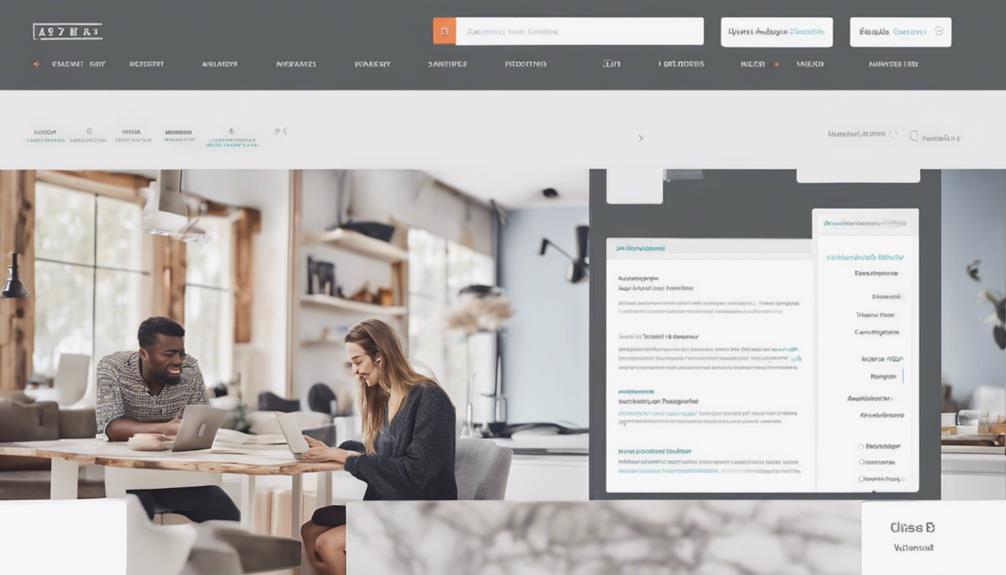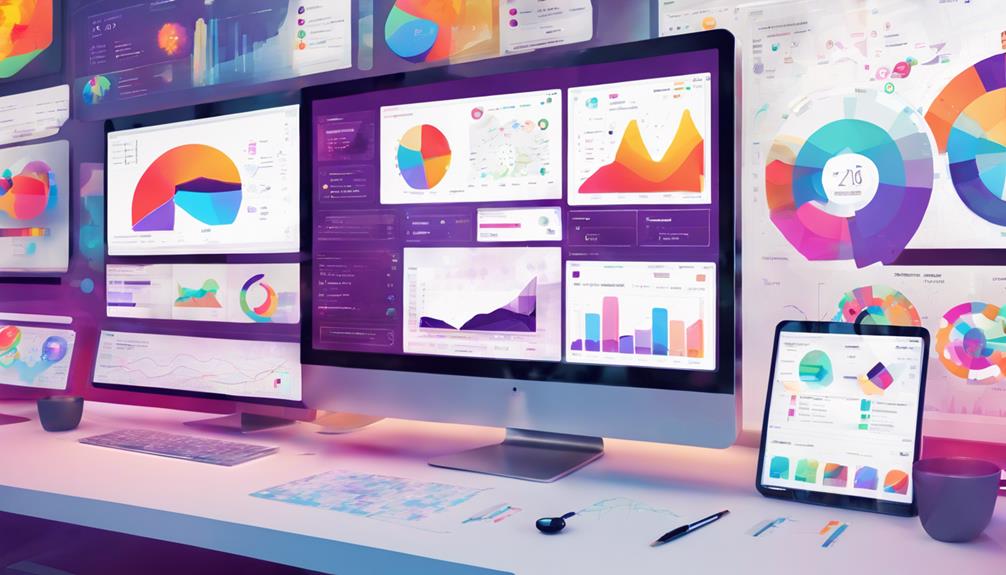You might not realize it, but page load speed can directly impact your organic SEO engagement by affecting your site's bounce rate. As you work to improve this aspect, it's crucial to remember that enhancing mobile responsiveness isn't just about making your site look good on smaller screens; it's about ensuring a seamless user experience. But where do you go from there? By focusing on user-friendly navigation and engaging content, you can keep visitors on your site longer. Let's explore how these elements, along with internal linking and social sharing, can elevate your SEO strategy.
Optimize Page Load Speed
When it comes to boosting organic SEO engagement, optimizing your page load speed is crucial. A fast-loading site not only improves user experience but also enhances your search engine rankings. According to Google, 53% of mobile users abandon sites that take longer than three seconds to load. This bounce rate directly impacts your SEO metrics, leading to lower engagement and reduced visibility.
Start by conducting a speed test using tools like Google PageSpeed Insights. This will provide you with specific data on your current load times and highlight areas for improvement. Keywords related to "reduce server response times" and "optimize images" often emerge as common culprits affecting speed. Tackling these issues can shave precious seconds off your load time.
Compressing images is an effective strategy. Use formats like WebP, which maintain quality while reducing file size. Additionally, enable browser caching to store static files, allowing returning users to experience faster load times. Minimize CSS and JavaScript to decrease the number of requests your server processes.
Another key factor is selecting a reliable Content Delivery Network (CDN). A CDN stores copies of your site across various locations globally, reducing latency by ensuring your content is delivered from the nearest server. This can dramatically improve load times for users worldwide.
Don't overlook server performance. Upgrading to a faster hosting plan or a dedicated server can significantly cut down load times.
Enhance Mobile Responsiveness

To enhance mobile responsiveness, you should first optimize page load speed, as studies show a 53% bounce rate increase with just a three-second delay.
Implementing responsive design is crucial, with over 50% of global web traffic originating from mobile devices.
Lastly, prioritize user-friendly navigation to reduce bounce rates and improve user engagement, as intuitive mobile experiences are a significant ranking factor.
Optimize Page Load Speed
Page load speed acts as a crucial determinant in enhancing mobile responsiveness and elevating organic SEO engagement. A one-second delay can reduce mobile conversions by up to 20%, emphasizing the importance of speed. Google studies reveal that mobile sites loading within five seconds see 70% longer sessions.
Faster pages earn higher search rankings, directly impacting organic traffic. Prioritize optimizing your website's load time to boost user experience and search engine performance.
Start by analyzing your current speed with tools like Google PageSpeed Insights or GTmetrix. These tools provide insights into elements slowing you down. Consider compressing images, enabling browser caching, and minimizing JavaScript to improve loading times. A study by Akamai shows a 100-millisecond improvement in load time can increase conversions by 7%.
Furthermore, use a Content Delivery Network (CDN) to distribute your content more efficiently. CDNs reduce latency by serving content from the nearest server to your user's location. This can significantly enhance your page load speed, especially on mobile devices.
Implement Responsive Design
Achieving optimal page load speed sets the stage for another key factor in boosting organic SEO engagement: implementing responsive design. In today's digital landscape, more than half of global website traffic comes from mobile devices. If your site isn't mobile-friendly, you're likely losing a significant portion of potential visitors.
Responsive design ensures your website adapts seamlessly to any screen size, enhancing the user experience and improving SEO rankings.
To effectively implement responsive design, focus on these key strategies:
- Flexible Layouts: Use fluid grids and flexible images. This helps your site adjust to different screen sizes without compromising design integrity.
- Touch-Friendly Elements: Ensure buttons and interactive elements are large enough for easy tapping, reducing user frustration and bounce rates.
- Consistent Experience: Maintain a uniform appearance across devices. This builds trust and keeps visitors engaged longer, signaling search engines that your site is valuable.
Data shows that mobile-friendly sites rank higher on search engine results pages (SERPs). Google's mobile-first indexing means your mobile version is what gets indexed first, reinforcing the importance of responsive design.
Prioritize User-Friendly Navigation
Navigating a website shouldn't feel like solving a maze, yet many sites fall short in this area. User-friendly navigation is crucial for boosting organic SEO engagement. Studies show that 94% of users prioritize easy navigation when visiting a site. It directly impacts your site's bounce rate, which can increase by 123% if users struggle to find what they need.
By organizing your site logically with clear labels and intuitive menus, you enhance user experience and keep visitors engaged longer.
To further improve navigation, focus on mobile responsiveness, as over 50% of web traffic now comes from mobile devices. Google's mobile-first indexing means your site must be optimized for smaller screens. Ensure your navigation is thumb-friendly, with easily clickable elements and a clean, clutter-free design.
Use tools like heatmaps to analyze user interaction and identify navigation pain points.
Keywords like "user-friendly navigation" and "mobile responsiveness" are essential for your SEO strategy. When users find your site easy to navigate, they're more likely to spend time exploring your content, reducing bounce rates and signaling to search engines that your site is valuable, ultimately boosting your organic rankings.
Improve Site Navigation

To improve organic SEO engagement, you must simplify user pathways by streamlining site navigation.
Data shows that 94% of users cite poor navigation as a reason for abandoning a website, highlighting the importance of an enhanced menu structure.
Simplify User Pathways
Streamlining user pathways is crucial for enhancing site navigation and boosting organic SEO engagement. When visitors easily find what they're looking for, they stay longer and explore more, signaling search engines that your site is valuable.
A seamless user experience can lead to a 50% increase in page views, translating to improved search rankings. To achieve this, you need to analyze user behavior and identify common friction points.
Here's how to simplify user pathways effectively:
- Prioritize Mobile Optimization: With over 60% of web traffic coming from mobile devices, ensure your site is mobile-friendly. A responsive design enhances navigation and reduces bounce rates.
- Utilize Clear Call-to-Actions (CTAs): Strategically placed CTAs guide users through your site. They should be concise, compelling, and aligned with user intent, increasing conversion rates by up to 25%.
- Implement Internal Linking: Direct users to related content, improving time-on-site metrics. Strong internal linking can boost your average session duration by 40%.
Enhance Menu Structure
A well-organized menu acts as a roadmap for users, directly impacting site navigation and organic SEO performance. Research shows that 76% of users say ease of navigation is the most important aspect of a website. By enhancing your menu structure, you can improve user experience, reduce bounce rates, and ultimately boost your organic rankings.
Start by analyzing your menu's layout. Is it intuitive? Does it prioritize high-traffic pages? Use tools like Google Analytics to identify which pages attract the most visitors and ensure they're easily accessible.
Keyword-focused menu labels are crucial. Opt for descriptive terms that reflect user search queries. For instance, replacing generic labels like "Services" with specific ones such as "SEO Consulting" can enhance relevance and search visibility.
Moreover, a clear hierarchy is essential. Organize categories logically, using submenus sparingly to prevent overwhelming users.
Don't forget mobile navigation. With mobile internet usage surpassing desktop, a responsive menu is non-negotiable. Implement a mobile-first design approach, ensuring menu elements are easy to tap and read.
Regularly test your site's navigation on various devices to ensure consistency and effectiveness. By enhancing your menu structure, you boost both user satisfaction and organic SEO engagement.
Craft Engaging Content

Engaging content is crucial for boosting organic SEO engagement, as it directly impacts user retention and conversion rates. When users find your content compelling, they're more likely to stay on your page longer, reducing bounce rates, and increasing the likelihood of conversions.
Data shows that 47% of consumers read 3-5 pieces of content before engaging with a sales representative. To craft engaging content, focus on creating value-driven, keyword-rich material that resonates with your target audience.
Start by understanding your audience's needs and preferences. Use analytics tools to identify which content formats and topics perform best. Once you've gathered enough data, tailor your content to meet those interests.
- Leverage storytelling techniques: Craft narratives that captivate your audience and encourage them to connect emotionally with your brand. Storytelling can increase content recall by up to 22 times compared to facts alone.
- Incorporate visuals: Break up text with images, infographics, or videos. Visual content can increase readership by 80%, making your content more digestible and shareable.
- Use compelling headlines: 80% of people will read your headlines, but only 20% will read the rest. Make every headline count by using power words and numbers to catch readers' attention.
Consistently updating your content is key. Search engines favor fresh, relevant information, so regularly refresh your materials to maintain high rankings.
Utilize Internal Linking

When you strategically utilize internal linking, you can enhance site navigation by directing users seamlessly to relevant content, shown to boost user engagement by up to 40%.
Strengthening content connections through targeted keywords can improve the semantic relationship between pages, increasing the likelihood of search engine recognition.
Furthermore, by distributing link equity, internal links can significantly increase the page authority of less prominent pages, improving their search rankings over time.
Enhance Site Navigation
Many websites overlook the power of internal linking as a strategic tool to enhance site navigation and boost organic SEO engagement. By optimizing your site's internal linking structure, you can ensure search engines efficiently crawl your pages, thereby improving your site's visibility.
Data shows that sites with well-structured internal links see up to a 40% increase in page views. The key is to keep visitors engaged longer by making it easy for them to find relevant content, which reduces bounce rates by up to 30%.
Consider these internal linking strategies:
- Keyword-Rich Anchor Text: Use descriptive keywords in your anchor text to provide context about the linked content. This helps search engines understand content relationships, rewarding you with higher rankings.
- Logical Hierarchy: Organize your internal links in a logical hierarchy to guide users through your content naturally. This structure enhances user experience and increases the likelihood of conversions.
- Link to High-Authority Pages: Direct users to pages with high authority within your site. This not only improves engagement but also signals to search engines the importance of these pages.
Strengthen Content Connections
A well-crafted internal linking strategy is the cornerstone of strengthening content connections on your website. By strategically linking related content, you boost SEO engagement and improve user experience. Internal links distribute page authority and create a hierarchy of information, guiding users through their journey on your site. When executed effectively, internal linking enhances keyword relevance and keeps users engaged longer.
To visualize this strategy, consider the following table that outlines internal linking practices:
| Internal Linking Practice | Benefit |
|---|---|
| Link Anchor Text | Increases keyword relevance |
| Contextual Links | Enhances user engagement |
| Link to High-Traffic Pages | Boosts visibility |
| Use Descriptive Links | Improves click-through rate |
Incorporating keyword-rich anchor text is crucial. It not only reinforces the topic but also signals to search engines the relevance of linked content. Contextual links, when placed strategically, can significantly enhance user engagement by providing additional resources. Directing links to high-traffic pages amplifies their visibility and drives more internal traffic. Descriptive links, on the other hand, encourage users to click through, increasing the click-through rate.
Track your website's internal link structure using tools like Google Search Console. Analyze link performance to identify opportunities for optimization. By focusing on these data-driven internal linking practices, you'll strengthen content connections and improve your site's SEO engagement.
Increase Page Authority
Building up page authority through strategic internal linking can significantly elevate your site's SEO performance. By effectively organizing your content and creating pathways between pages, you can enhance relevancy and distribute link equity throughout your site.
Data shows that websites with strong internal linking structures tend to have higher page authority and better keyword rankings. So, how can you leverage this strategy?
- Identify High-Authority Pages: Use tools like Google Analytics to pinpoint pages with high authority. Linking these pages to others can pass on valuable link juice.
- Use Descriptive Anchor Text: Integrate keywords that describe the linked page's content. This provides search engines with context, improving your site's keyword relevancy.
- Create a Logical Structure: Ensure your linking strategy aligns with your site's hierarchy. Well-structured navigation guides users and search engines to critical pages.
Research indicates that pages with numerous internal links are often crawled more frequently by search engines, leading to improved indexation.
Focusing on these internal linking best practices won't only boost page authority but also enhance user experience by making your site easier to navigate.
Prioritize User-Friendly Design

User-friendly design is crucial for enhancing organic SEO engagement, influencing how visitors interact with your website and its content. When users find your site easy to navigate and visually appealing, they're more likely to stay longer, reducing bounce rates and increasing dwell time—key metrics that search engines like Google consider when ranking pages.
To prioritize user-friendly design, focus on mobile responsiveness, page load speed, and intuitive navigation. With over 50% of global website traffic coming from mobile devices, ensuring your site performs well on smaller screens is non-negotiable. A responsive design automatically adjusts for various devices, improving the user experience and, consequently, your SEO metrics.
Consider the following data-driven insights:
| Metric | Impact on SEO |
|---|---|
| Page Load Speed | Faster sites rank higher |
| Mobile Responsiveness | Essential for mobile-first indexing |
| Intuitive Navigation | Enhances user experience |
Page load speed is another critical factor. Research shows that 53% of mobile users abandon sites that take longer than three seconds to load. Optimizing images, leveraging browser caching, and minimizing HTTP requests can significantly reduce load times, positively impacting both user engagement and search rankings.
Lastly, intuitive navigation ensures that users can easily find what they're looking for, decreasing frustration and increasing the likelihood of conversions. Use clear labels, maintain a logical hierarchy, and provide a search bar for enhanced usability.
Encourage Social Sharing

In addition to a user-friendly design, encouraging social sharing can significantly amplify your organic SEO engagement. Social signals, such as likes, shares, and comments, are indirect ranking factors that search engines like Google consider when determining the relevance and authority of your content.
When users share your content, it not only increases visibility but also enhances your backlink profile, driving more organic traffic to your site.
To effectively encourage social sharing, consider these data-driven strategies:
- Integrate Social Sharing Buttons: Place them prominently on your site, particularly near headlines or at the end of articles. Studies show that content with visible sharing buttons is seven times more likely to be shared.
- Craft Shareable Content: Create compelling headlines and visuals. Content that's emotionally engaging or provides value, such as tutorials or infographics, has a higher likelihood of being shared.
- Optimize for Mobile Users: With 54% of social media usage occurring on mobile devices, ensure your site is mobile-friendly. Fast-loading pages and responsive design can lead to a 34% increase in shares.
Analyzing social sharing analytics is crucial. Use tools like Google Analytics to track which pieces of content get shared the most and which platforms drive the most traffic.
This data helps you refine your strategy, focusing on the content types and platforms that maximize engagement.
Implement Interactive Elements

To enhance user engagement and organic SEO, consider integrating interactive elements into your content strategy. Incorporating features like quizzes, polls, and interactive infographics can transform passive viewers into active participants. According to a study by Content Marketing Institute, interactive content generates twice as much engagement as static content. This boost in engagement signals to search engines that your content is valuable, potentially improving your rankings.
Interactive elements also increase the time users spend on your site, a critical SEO metric. When visitors engage with interactive content, they tend to linger longer, sending positive signals to search engines about the relevance and quality of your pages. Google's RankBrain, an AI-driven component of its search algorithm, considers user interaction metrics like dwell time and click-through rates, making interactive elements a strategic addition to your SEO efforts.
Moreover, interactive content can improve user experience by making information more digestible and engaging. For instance, interactive infographics can break down complex data into visually appealing, easy-to-understand formats. This not only enhances user satisfaction but also encourages social sharing, further amplifying your content's reach and authority.
When implementing interactive elements, ensure they're mobile-friendly. Mobile searches account for over 60% of global website traffic, according to Statista. Optimizing your interactive content for mobile users ensures a seamless experience across all devices, which is crucial for maintaining high engagement levels.
Focus on Content Readability

There's an undeniable truth about content readability—it's a pivotal factor in SEO success. When your content is easy to read, users engage more, bounce less, and are more likely to convert. According to a study by the Nielsen Norman Group, users only read about 28% of the words on a page, highlighting the need for concise and clear content.
To capture attention, you need to focus on several key elements.
First, consider the structure of your content. A well-organized piece with headers and subheaders not only boosts readability but also improves your keyword placement. Google's algorithms favor structured content, increasing your chances of ranking higher.
- Use short paragraphs and sentences: Aim for no more than 20 words per sentence. This enhances comprehension and keeps users engaged.
- Incorporate visuals: Images, infographics, and videos can break up text and make information digestible. Visuals are processed 60,000 times faster than text, according to 3M Corporation.
- Choose a readable font: Size and style matter. Stick with fonts that are easy on the eyes, typically sans-serif, with a size of at least 16px.
Additionally, readability scores like Flesch-Kincaid can offer valuable insights. Aim for an 8th-grade reading level to ensure your content is accessible to a broad audience.
By optimizing for readability, you're not just enhancing user experience but also aligning with SEO best practices. Keywords naturally flow in well-crafted content, leading to better visibility and engagement.
Monitor User Behavior Analytics

Understanding how users interact with your website is crucial for optimizing organic SEO engagement. By monitoring user behavior analytics, you can gain insights into what's working and what needs improvement. Tools like Google Analytics provide detailed data on metrics such as bounce rate, average session duration, and pages per session. These metrics help you identify which pages keep users engaged and which ones might be driving them away.
Start by analyzing bounce rates. A high bounce rate often signals that users aren't finding what they're looking for, which can negatively impact your SEO rankings. By identifying pages with high bounce rates, you can make necessary adjustments to content, keywords, or page layout to improve user retention.
Next, focus on session duration and pages per session. Longer session durations typically indicate that users are engaged with your content. If users are visiting multiple pages, it's a sign that your internal linking strategy is effective and your content is relevant. Use these insights to refine your keyword strategy, ensuring that it aligns with user intent and keeps visitors exploring your site.
Heatmaps and session recordings provide visual insights into user interactions. They show where users click, how far they scroll, and what elements they engage with most. Use this data to optimize your site's design and improve the user experience, which can lead to higher rankings and more organic traffic.
Incorporate A/B testing to experiment with different elements on high-traffic pages. By continuously monitoring and adjusting based on analytics, you can enhance user engagement, boost SEO performance, and drive sustainable growth.
Conclusion
By implementing these data-driven strategies, you're set to significantly boost your organic SEO engagement. Isn't it time you optimized your site's speed and mobile responsiveness for a seamless user experience? With user-friendly navigation, engaging content, and strategic internal linking, you're keeping visitors engaged longer. Encouraging social sharing and adding interactive elements further amplifies your reach. By monitoring user behavior and focusing on readability, you're making informed decisions. Ready to elevate your SEO game?


Leave a Reply